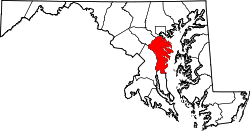Jacobsville, Maryland | |
|---|---|
| Coordinates: 39°07′17″N76°31′03″W / 39.12139°N 76.51750°W | |
| Country | |
| State | |
| County | |
| Time zone | UTC-5 (Eastern (EST)) |
| • Summer (DST) | UTC-4 (EDT) |
Jacobsville is an unincorporated community in Anne Arundel County, Maryland, United States. [1]


